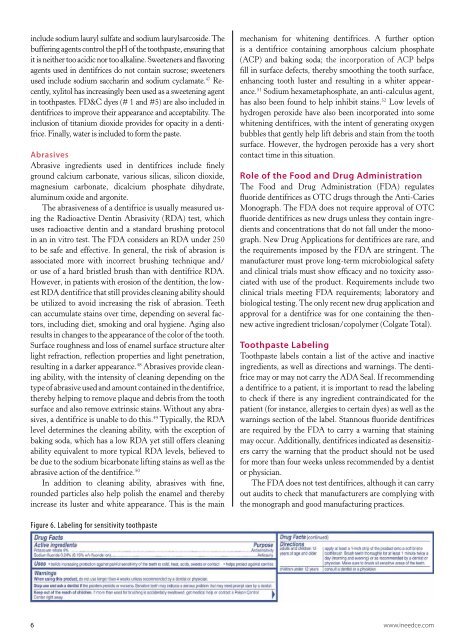Reflections on Dentifrice Ingredients, Benefits and ... - IneedCE.com
Reflections on Dentifrice Ingredients, Benefits and ... - IneedCE.com
Reflections on Dentifrice Ingredients, Benefits and ... - IneedCE.com
Create successful ePaper yourself
Turn your PDF publications into a flip-book with our unique Google optimized e-Paper software.
include sodium lauryl sulfate <strong>and</strong> sodium laurylsarcoside. The<br />
buffering agents c<strong>on</strong>trol the pH of the toothpaste, ensuring that<br />
it is neither too acidic nor too alkaline. Sweeteners <strong>and</strong> flavoring<br />
agents used in dentifrices do not c<strong>on</strong>tain sucrose; sweeteners<br />
used include sodium saccharin <strong>and</strong> sodium cyclamate. 47 Recently,<br />
xylitol has increasingly been used as a sweetening agent<br />
in toothpastes. FD&C dyes (# 1 <strong>and</strong> #5) are also included in<br />
dentifrices to improve their appearance <strong>and</strong> acceptability. The<br />
inclusi<strong>on</strong> of titanium dioxide provides for opacity in a dentifrice.<br />
Finally, water is included to form the paste.<br />
Abrasives<br />
Abrasive ingredients used in dentifrices include finely<br />
ground calcium carb<strong>on</strong>ate, various silicas, silic<strong>on</strong> dioxide,<br />
magnesium carb<strong>on</strong>ate, dicalcium phosphate dihydrate,<br />
aluminum oxide <strong>and</strong> arg<strong>on</strong>ite.<br />
The abrasiveness of a dentifrice is usually measured using<br />
the Radioactive Dentin Abrasivity (RDA) test, which<br />
uses radioactive dentin <strong>and</strong> a st<strong>and</strong>ard brushing protocol<br />
in an in vitro test. The FDA c<strong>on</strong>siders an RDA under 250<br />
to be safe <strong>and</strong> effective. In general, the risk of abrasi<strong>on</strong> is<br />
associated more with incorrect brushing technique <strong>and</strong>/<br />
or use of a hard bristled brush than with dentifrice RDA.<br />
However, in patients with erosi<strong>on</strong> of the dentiti<strong>on</strong>, the lowest<br />
RDA dentifrice that still provides cleaning ability should<br />
be utilized to avoid increasing the risk of abrasi<strong>on</strong>. Teeth<br />
can accumulate stains over time, depending <strong>on</strong> several factors,<br />
including diet, smoking <strong>and</strong> oral hygiene. Aging also<br />
results in changes to the appearance of the color of the tooth.<br />
Surface roughness <strong>and</strong> loss of enamel surface structure alter<br />
light refracti<strong>on</strong>, reflecti<strong>on</strong> properties <strong>and</strong> light penetrati<strong>on</strong>,<br />
resulting in a darker appearance. 48 Abrasives provide cleaning<br />
ability, with the intensity of cleaning depending <strong>on</strong> the<br />
type of abrasive used <strong>and</strong> amount c<strong>on</strong>tained in the dentifrice,<br />
thereby helping to remove plaque <strong>and</strong> debris from the tooth<br />
surface <strong>and</strong> also remove extrinsic stains. Without any abrasives,<br />
a dentifrice is unable to do this. 49 Typically, the RDA<br />
level determines the cleaning ability, with the excepti<strong>on</strong> of<br />
baking soda, which has a low RDA yet still offers cleaning<br />
ability equivalent to more typical RDA levels, believed to<br />
be due to the sodium bicarb<strong>on</strong>ate lifting stains as well as the<br />
abrasive acti<strong>on</strong> of the dentifrice. 50<br />
In additi<strong>on</strong> to cleaning ability, abrasives with fine,<br />
rounded particles also help polish the enamel <strong>and</strong> thereby<br />
increase its luster <strong>and</strong> white appearance. This is the main<br />
mechanism for whitening dentifrices. A further opti<strong>on</strong><br />
is a dentifrice c<strong>on</strong>taining amorphous calcium phosphate<br />
(ACP) <strong>and</strong> baking soda; the incorporati<strong>on</strong> of ACP helps<br />
fill in surface defects, thereby smoothing the tooth surface,<br />
enhancing tooth luster <strong>and</strong> resulting in a whiter appearance.<br />
51 Sodium hexametaphosphate, an anti-calculus agent,<br />
has also been found to help inhibit stains. 52 Low levels of<br />
hydrogen peroxide have also been incorporated into some<br />
whitening dentifrices, with the intent of generating oxygen<br />
bubbles that gently help lift debris <strong>and</strong> stain from the tooth<br />
surface. However, the hydrogen peroxide has a very short<br />
c<strong>on</strong>tact time in this situati<strong>on</strong>.<br />
Role of the Food <strong>and</strong> Drug Administrati<strong>on</strong><br />
The Food <strong>and</strong> Drug Administrati<strong>on</strong> (FDA) regulates<br />
fluoride dentifrices as OTC drugs through the Anti-Caries<br />
M<strong>on</strong>ograph. The FDA does not require approval of OTC<br />
fluoride dentifrices as new drugs unless they c<strong>on</strong>tain ingredients<br />
<strong>and</strong> c<strong>on</strong>centrati<strong>on</strong>s that do not fall under the m<strong>on</strong>ograph.<br />
New Drug Applicati<strong>on</strong>s for dentifrices are rare, <strong>and</strong><br />
the requirements imposed by the FDA are stringent. The<br />
manufacturer must prove l<strong>on</strong>g-term microbiological safety<br />
<strong>and</strong> clinical trials must show efficacy <strong>and</strong> no toxicity associated<br />
with use of the product. Requirements include two<br />
clinical trials meeting FDA requirements; laboratory <strong>and</strong><br />
biological testing. The <strong>on</strong>ly recent new drug applicati<strong>on</strong> <strong>and</strong><br />
approval for a dentifrice was for <strong>on</strong>e c<strong>on</strong>taining the thennew<br />
active ingredient triclosan/copolymer (Colgate Total).<br />
Toothpaste Labeling<br />
Toothpaste labels c<strong>on</strong>tain a list of the active <strong>and</strong> inactive<br />
ingredients, as well as directi<strong>on</strong>s <strong>and</strong> warnings. The dentifrice<br />
may or may not carry the ADA Seal. If re<strong>com</strong>mending<br />
a dentifrice to a patient, it is important to read the labeling<br />
to check if there is any ingredient c<strong>on</strong>traindicated for the<br />
patient (for instance, allergies to certain dyes) as well as the<br />
warnings secti<strong>on</strong> of the label. Stannous fluoride dentifrices<br />
are required by the FDA to carry a warning that staining<br />
may occur. Additi<strong>on</strong>ally, dentifrices indicated as desensitizers<br />
carry the warning that the product should not be used<br />
for more than four weeks unless re<strong>com</strong>mended by a dentist<br />
or physician.<br />
The FDA does not test dentifrices, although it can carry<br />
out audits to check that manufacturers are <strong>com</strong>plying with<br />
the m<strong>on</strong>ograph <strong>and</strong> good manufacturing practices.<br />
Figure 6. Labeling for sensitivity toothpaste<br />
6 www.ineedce.<strong>com</strong>

















